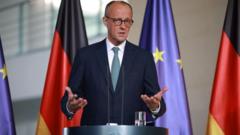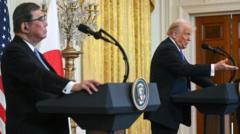Amid escalating economic distress, Ghana's ambitious $400 million cathedral has turned into a symbol of political strife and public discontent, revealing the pitfalls of grand ambitions met with harsh realities.
Ghana's Grand Cathedral Dream: A Monument to Mismanagement

Ghana's Grand Cathedral Dream: A Monument to Mismanagement
Amidst economic turmoil, Ghana's flagship cathedral project leaves citizens disillusioned as funds vanish into unfulfilled promises.
The construction site of Ghana's national cathedral in Accra sits eerily silent, with its only occupants being the abandoned machinery and the sounds of nature reclaiming the area. Designed by renowned architect David Adjaye, the cathedral was supposed to be an emblem of unity and a national monument, akin to the National Cathedral in Washington, D.C., but it has become a mere “expensive hole.”
Ghana's past administration, led by President Nana Akufo-Addo, allocated approximately $58 million of taxpayer funds to this grand vision, a significant expenditure for a nation grappling with a debt crisis. As the economy falters—described by the new finance minister as being in “severe distress”—the project stalls, shoveling disappointment upon a populace already weary of broken promises.
Residents, including fervent believers like Praise Chinedu, express anger and skepticism over the cathedral’s unutilized funds. “They have only dug a hole—a big hole,” he remarks, reflecting a common sentiment among those drawn to the site for its potential glory, now overshadowed by grim reality. As local churches flourish around the underwhelming project, community members hope for divine intervention to rectify what many view as a misallocation of resources that should have supported the ailing economy instead.
While the cathedral was envisioned to inspire and unite, its ongoing failure serves as a reminder of how well-intentioned projects can spiral into monuments of neglect when fiscal priorities are mismanaged and transparency lapses.
Ghana's past administration, led by President Nana Akufo-Addo, allocated approximately $58 million of taxpayer funds to this grand vision, a significant expenditure for a nation grappling with a debt crisis. As the economy falters—described by the new finance minister as being in “severe distress”—the project stalls, shoveling disappointment upon a populace already weary of broken promises.
Residents, including fervent believers like Praise Chinedu, express anger and skepticism over the cathedral’s unutilized funds. “They have only dug a hole—a big hole,” he remarks, reflecting a common sentiment among those drawn to the site for its potential glory, now overshadowed by grim reality. As local churches flourish around the underwhelming project, community members hope for divine intervention to rectify what many view as a misallocation of resources that should have supported the ailing economy instead.
While the cathedral was envisioned to inspire and unite, its ongoing failure serves as a reminder of how well-intentioned projects can spiral into monuments of neglect when fiscal priorities are mismanaged and transparency lapses.


















